I feel guilty about our front garden. Recently I have not been able to give it much attention and yet even the outside wall looks pretty with plants put in years ago.
We did manage to remove an old lilac tree early last autumn which has left us with a very blank wall. But I hope that other plants will be tall enough to remedy the situation by next year.
The white Spirea provides a bright distraction but does not attract much insect life apart from an odd butterfly in transit.
Not so my Choisya Sundance! It has lit up a shady wall all through the winter and is now full of fragrant flowers.
Its flowers are beautiful, perfumed and the pollen seems to be appreciated by this wild bee.
The tree peony is out and doing its bit to brighten up the wall.
The flowers are large and lightly scented.
The ground in front of the tree peony is covered by Cerinthe which has self-seeded. In the sunshine there is a constant buzz from the Anthophora bees…
and the bumble bees.
On the front patio I’ve planted three Camassia Leichtlinii caerulea. Last year I planted Camassia cusickii which I preferred but still I have plenty of bumble bees to watch as I have my morning coffee.
Then they obligingly move onto the potted lemon tree to help with the pollination there (this time it is a Bombus pratorum doing her pollinating stuff).
The Wisteria is the main feature of the front garden at the moment and it makes it presence known with its heavy perfume.
With Wisteria in France the Carpenter bees are ever present as well as the different kinds of bumble bees.
The honey bees come too but I doubt if they would get much nectar from the flowers if it had not been for the Carpenters and bumble bees leaving holes in the flowers to provide access for them.
All summer long my hardy fuschia puts up a marvellous show but I have neglected it this year and now new shoots are growing on the old stems that I should have cut down months ago.
The back garden and the bees have taken up too much of my time this year.
I am pleased with the willows put in as a screen where we frequently sit.
The dark tulips grow in front of the willows. Their petals are so dark that there seems a blush on their surface.
The cherry and apple trees are in flower but the Quince tree is a particular favourite with all the bees but more about the Quince tree later.
A couple of years ago we decided to try to grow a Wisteria into a tree. Actually, two survived the first stage and we put the best in a selected, choice situation. We did not know what to do with the other so we stuck it in the hedge. Yes, the good one died leaving the survivor to hang over the fence!
Perhaps that is one of the charms of gardening that things don’t always turn out as you expect them to. I left this dry, hollow log unadorned on a flower bed but by springtime Nature had adorned it with several mosses and a “wild” flower. Left to itself it is prettier than anything I could have confectioned.
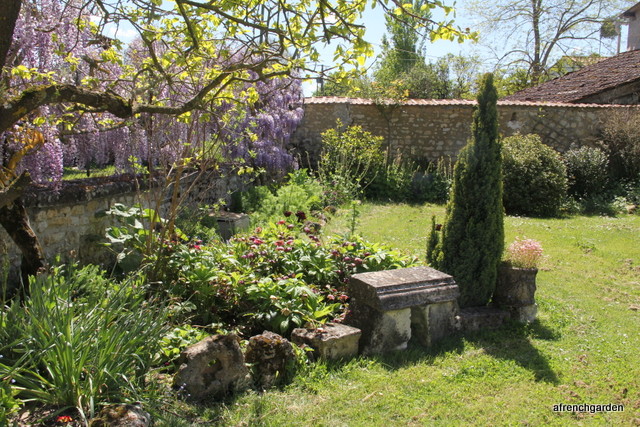
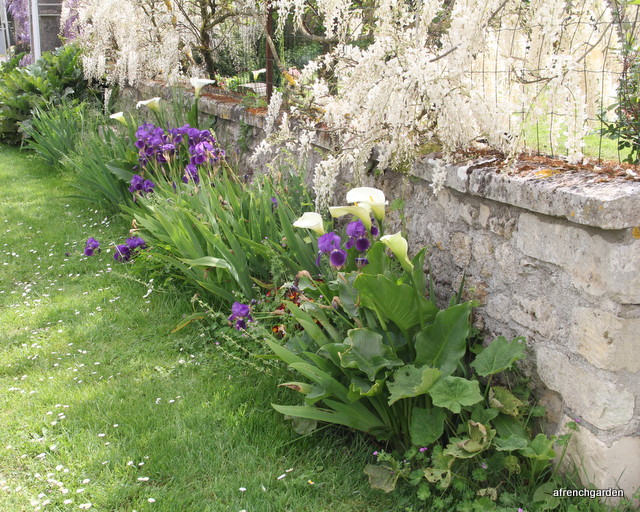

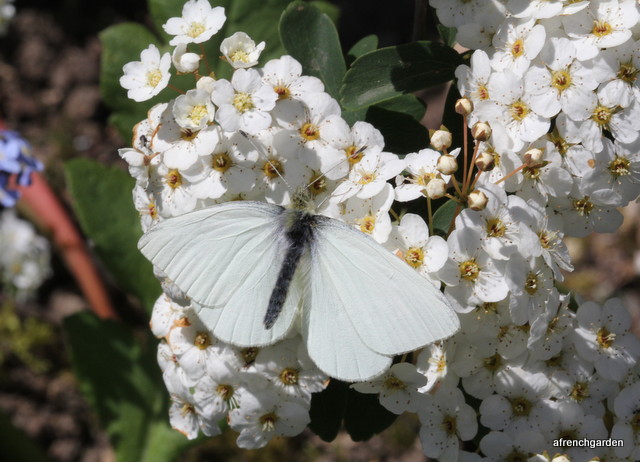
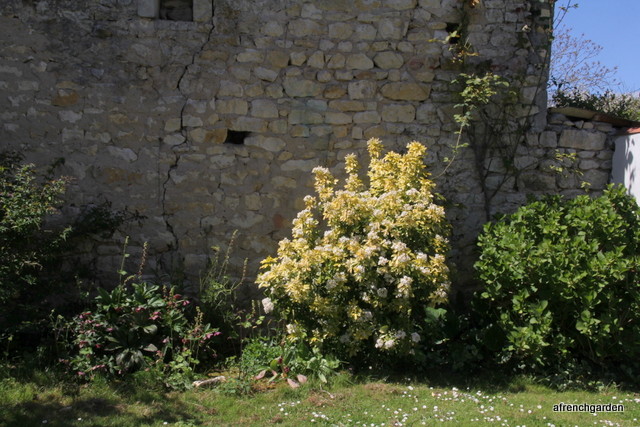




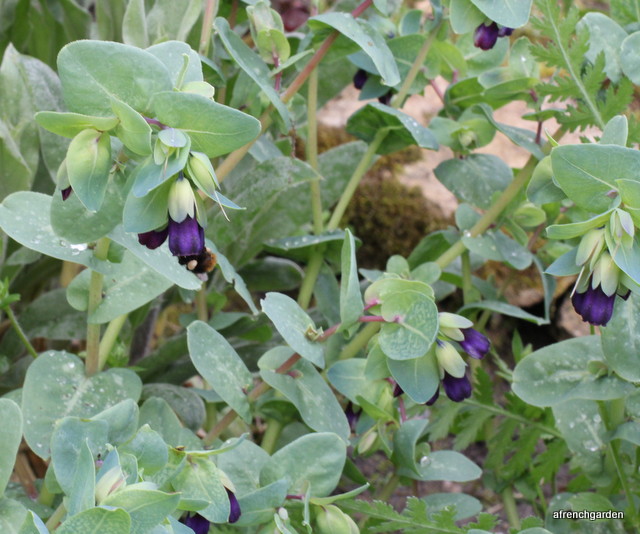





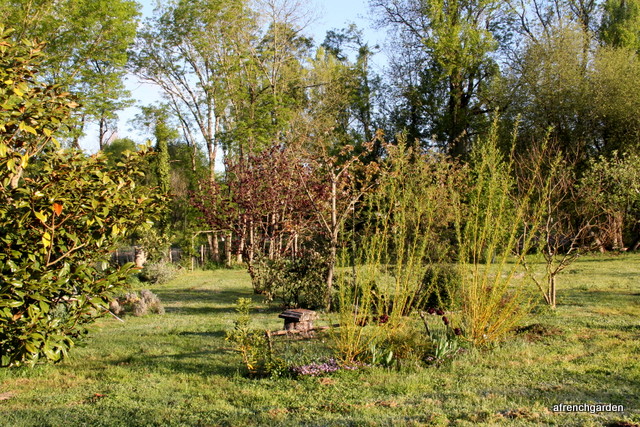
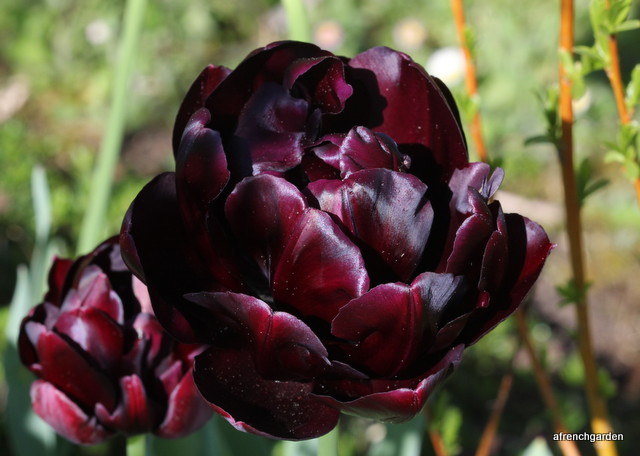

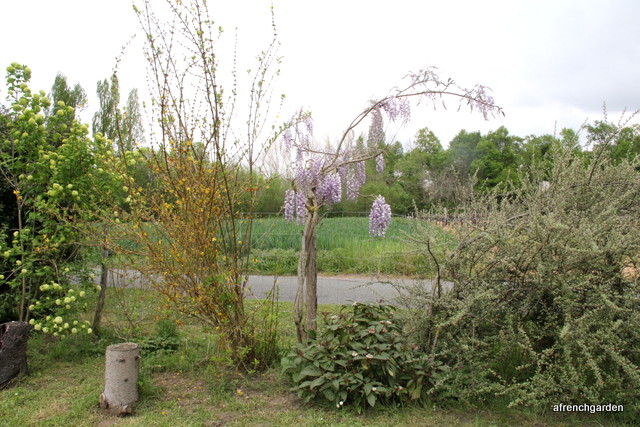

Beautiful! I like the calla/iris combination, the way they contrast. Isn’t that blank wall just begging for an espalier?
LikeLike
I must admit I had not thought of that. It just gets the morning sun so perhaps not good for all fruit tree. Any ideas? Amelia
LikeLiked by 1 person
Hmm.. There must be some flowering shrub that would take that sort of treatment but not need a full day of sun. Or maybe clematis on a trellis.
LikeLike
I’ll keep it in mind, sometimes you see just the right thing bye and bye.
LikeLiked by 1 person
Oh, what beautiful, beautiful pictures. Thank you for this!
LikeLike
Glad you enjoyed the walk in the garden. Amelia
LikeLiked by 1 person
I think your gardens are beautiful!
LikeLike
Thank you, we started putting in the some of the plants fifteen years ago even before we came to live here permanently so they are only starting to fill up now. Amelia
LikeLiked by 1 person
A very charming look at your charming garden. Wisteria is quite invasive here; I presume that is not the case in France.
LikeLike
It is a constant battle but if I had the strength I’d probably have more! Last year they flowered three times so they reward us well. We are constantly re-potting runners to give to friends, or as I mentioned we experimented in making them into a tree shape. So far the tree shape is easier to control. Amelia
LikeLiked by 2 people
what a lovely place you call your own. the plants contrasted with the old stone walls look so great! And I am always a great admirer of a little wild left to gardens.
LikeLike
Last weekend I listened to a talk trying to convince the audience that it was possible to leave a garden completely wild and use just the wild flowers or “weeds”. His example was to show us a wild field and at this time in the spring his ideas were quite convincing. However, I’d need to see one actually done and what it looks like in the summer and winter. You are allowed to add paths and the odd plant with this concept. Amelia
LikeLiked by 1 person
I would be afraid, that everything would get so thick, that one can’t even get through it. Nature tends do dense up, if allowed to….
LikeLike
It can have paths through it. Paths could be stones or even trodden paths. Where you tread leaves space for different plants to prosper. It is a concept I have difficult understanding.
LikeLike
I don’t think the carpenters nectar rob the wisteria — they climb right in the flowers and it is definitely a favourite with them (as are most big pea flowers). Probably one of the bumbles is doing the robbing.
LikeLike
I have actually watched the Carpenters piercing the flowers. Perhaps it is easier for them to land and pierce rather than land and push, although I agree I have seen them do both. Anecdotally, I feel I am seeing less in the Wisteria this year. It may be as the years go by there are more flowers in the garden and they are more spread out. Amelia
LikeLike
You may be running to catch up with April Amelia, as you would expect your garden is way ahead of us, the promise of things to come. First batch of cosmos up and growing in the green house, second batch planted today. I hope to have some to sell for our NGS open days, thank you.
LikeLike
Cosmos ready for planting will be very popular and I hope the days go well for you. Amelia
LikeLiked by 1 person
Good to see so much blossom, and the bees. Being on the south coast of the Mediterranean, our lemons are some way ahead of yours: I can almost smell the perfume in your garden! Would it be possible to grow a fig tree against the blank wall? I’ve seen one trained against a wall near the entrance to the herb garden at Kew, and it does a great job of covering the brickwork. Plus you’d get the fruit.
LikeLike
A very good suggestion but I developed a very severe allergy to figs some years ago. I cannot really come into contact with the fruit or anything it touches. I don’t understand how these things happen as I used to eat lots of the little green and the black figs when I was young. This is my only food allergy. Amelia
LikeLike
Even “neglected” your garden is lovely–and such a haven for the wild things.
LikeLike
Thank you, I hope it is finally coming to an easier more “maintenance” stage. Amelia
LikeLiked by 1 person
Hello Amelia,
Lovely pics and amazing to see Wisteria and Iris already in full flower. Are these always out now, or has it been an early year? The garden looks great,
Best wishes
Julian
LikeLike
Over here the spring has been late this year although not as late here as in other regions. So they are about at the right time, starting early April. The wild yellow Iris in the fields are out now too. Amelia
LikeLike
Hi Amelia, I am so wistful after reading your lovely post, your garden looks beautiful, we sheltered from the heat under a Wisteria in Spain and watched large Carpenter bees robbing nectar, the first time I had seen this close up. Thornhayes nursery suggest espaliered cooking plums, morello cherries or mid season cooking apples on an east facing wall. And your last photo is gorgeous, a plant to treasure.
LikeLike
I think Kourosh would go for the Morello cherry idea. Our cherries here feed our voracious birds but I don’t think they would go for cherries on a wall so much. Amelia
LikeLiked by 1 person
Tout est bien plus en avance par chez vous qu’à l’Ouest de la Bretagne où il fait encore bien frais !
LikeLiked by 1 person
Looks great – our French garden is in the chopping back stage so that we can see what is actually there 🙂
LikeLike
Don’t keep anything you don’t really like, be ruthless and it will be better in the long run. Amelia
LikeLiked by 1 person
if you are on Twitter you can see the before and after shots I am @entoporf
LikeLike
Do you know which Anthophora you see on the cerinthe?
Some years ago, inspired by one at Sissinghurst, I began growing a wisteria as a tree. It is now in a large pot and currently covered in fat buds about 4cm long. For the two flowering weeks it is a source of much comment!
LikeLike
It is Anthophora plumipes as it comes so early. I think A.retusa is around now but I cannot tell the difference when they are in flight. I don’t get black A. plumipes females here. I think keeping a Wisteria in a pot is a great idea. I did not know it was possible but at least it is an excellent method to keep it under control. Amelia
LikeLike
It is certainly the Carpenter bees here that love the wisteria above all the other flowers and I can confirm that they piece the flowers to the point of destroying them to get to the nectar. The terrace was covered in drifts of petals mostly from those damaged by the bees, but I don’t mind, there were so many flowers. The noise sitting under the wisteria was almost deafening! Here’s a link to a blog you may not have found, Cath often writes about bees and she keeps them too. https://absentgardener.com/2016/05/01/flowers-for-bees-in-mid-summer/
LikeLike
Thanks for the link, she seems as besotted as me 🙂 Amelia
LikeLiked by 2 people
I enjoyed your observation about the carpenter bees making foraging easier for the honeybees. With the cold spring, we’re still running to catch up with the garden project this year. I discovered that many of the plants in our garden were not perennials and a fair few were not even ours (overgrowth from next door), which means there’s considerable scope for re-planting. I’ve been making my planting lists for a truly year-round bee-friendly garden by reading your blog, so thank you for the inspiration. Adding quince now…
LikeLike
I keep a wish list Word document on the computer and when I come to an interesting flower or tree (i.e. bee friendly :)) on a blog I make a note of it. I then print it off when I go to the U.K. and if I see any while I visit the garden centres I can treat myself. The more exact the name the better it is if you are trying to attract pollinators. Amelia
LikeLike